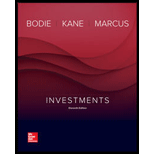
Investments
11th Edition
ISBN: 9781259277177
Author: Zvi Bodie Professor, Alex Kane, Alan J. Marcus Professor
Publisher: McGraw-Hill Education
expand_more
expand_more
format_list_bulleted
Question
Chapter 16, Problem 3PS
Summary Introduction
Adequate Information:
In this situation, Nine year bond possesses duration of the 7.194 years and yield of 10%. If there is a change in the yield of bond by 50 basis points
To calculate:
Percentage change in the price of the bond
Introduction:
Bond refers to the debt instrument pertaining to which loan is provided by the investor to the governmental or corporate entity for a definite time period at a fixed or variable rate of interest.
Expert Solution & Answer
Want to see the full answer?
Check out a sample textbook solution
Students have asked these similar questions
Need answer.
Solve plz now
Precious metal qn solve .
Chapter 16 Solutions
Investments
Ch. 16 - Prob. 1PSCh. 16 - Prob. 2PSCh. 16 - Prob. 3PSCh. 16 - Prob. 4PSCh. 16 - Prob. 5PSCh. 16 - Prob. 6PSCh. 16 - Prob. 7PSCh. 16 - Prob. 8PSCh. 16 - Prob. 9PSCh. 16 - Prob. 10PS
Ch. 16 - Prob. 11PSCh. 16 - Prob. 12PSCh. 16 - Prob. 13PSCh. 16 - Prob. 14PSCh. 16 - Prob. 15PSCh. 16 - Prob. 16PSCh. 16 - Prob. 17PSCh. 16 - Prob. 18PSCh. 16 - Prob. 19PSCh. 16 - Prob. 20PSCh. 16 - Prob. 21PSCh. 16 - Prob. 22PSCh. 16 - Prob. 23PSCh. 16 - Prob. 24PSCh. 16 - Prob. 25PSCh. 16 - Prob. 1CPCh. 16 - Prob. 2CPCh. 16 - Prob. 3CPCh. 16 - Prob. 4CPCh. 16 - Prob. 5CPCh. 16 - Prob. 6CPCh. 16 - Prob. 7CPCh. 16 - Prob. 8CPCh. 16 - Prob. 9CPCh. 16 - Prob. 10CPCh. 16 - Prob. 11CPCh. 16 - Prob. 12CPCh. 16 - Prob. 13CP
Knowledge Booster
Learn more about
Need a deep-dive on the concept behind this application? Look no further. Learn more about this topic, finance and related others by exploring similar questions and additional content below.Similar questions
arrow_back_ios
SEE MORE QUESTIONS
arrow_forward_ios
Recommended textbooks for you
 Intermediate Financial Management (MindTap Course...FinanceISBN:9781337395083Author:Eugene F. Brigham, Phillip R. DavesPublisher:Cengage Learning
Intermediate Financial Management (MindTap Course...FinanceISBN:9781337395083Author:Eugene F. Brigham, Phillip R. DavesPublisher:Cengage Learning EBK CONTEMPORARY FINANCIAL MANAGEMENTFinanceISBN:9781337514835Author:MOYERPublisher:CENGAGE LEARNING - CONSIGNMENT
EBK CONTEMPORARY FINANCIAL MANAGEMENTFinanceISBN:9781337514835Author:MOYERPublisher:CENGAGE LEARNING - CONSIGNMENT

Intermediate Financial Management (MindTap Course...
Finance
ISBN:9781337395083
Author:Eugene F. Brigham, Phillip R. Daves
Publisher:Cengage Learning

EBK CONTEMPORARY FINANCIAL MANAGEMENT
Finance
ISBN:9781337514835
Author:MOYER
Publisher:CENGAGE LEARNING - CONSIGNMENT
What is modified duration? | Dejargoned; Author: Mint;https://www.youtube.com/watch?v=5yLIybzb_OQ;License: Standard YouTube License, CC-BY